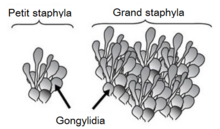
Gongylidia (singular gongylidium) are hyphal swellings of fungus cultivated by higher-attine genera of fungus-growing ants. This fungus no longer exists naturally outside the ant colonies.
Developing larvae feed on the gongylidia and distributed throughout the colony to feed workers, soldiers, and the queen. [1] They are ellipsoid, about 30-50 micrometres in diameter, [2] rich in lipids and carbohydrates derived from the leaves, [3] and are produced in clusters (called staphylae). [4]

See also
References
- ^ Raupp, Michael J. (February 12, 2007). "Bug of the Week". Archived from the original on 2011-07-20. Retrieved 2019-12-31.
- ^ Gover, D.W. "Fungal Agriculture and Engineering in Ants" (PDF).
- ^ Currie, Cameron R. (October 2001). "A community of Ants, Fungi, and Bacteria: A Multilateral Approach to Studying Symbiosis" (PDF). Annual Review of Microbiology. 55 (1): 357–380. doi: 10.1146/annurev.micro.55.1.357. hdl: 1808/835. PMID 11544360. Retrieved 2021-01-14.
- ^ "Integrative Biology" (PDF). Biosci.utexas.edu. Retrieved 2015-11-06.